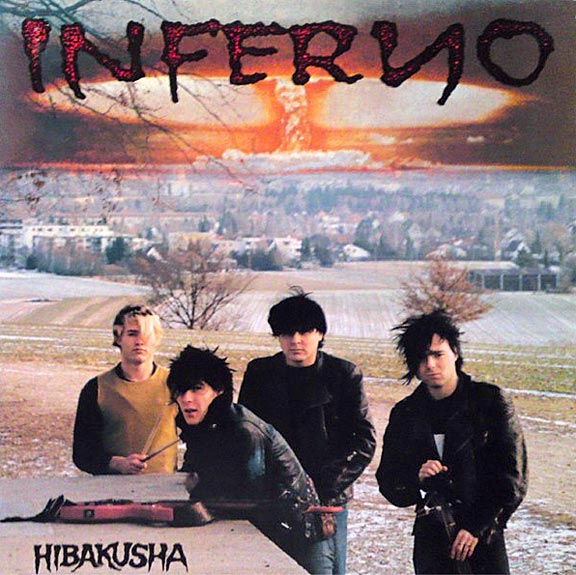Hibakusha – Inferno
August 6th, 2013 marks the 68th anniversary of the U.S. atomic bombing of Hiroshima, Japan.
Activists continue to protest against nuclear weaponry, and nations continue to build and possess them. I have written about the atomic bombings of Hiroshima and Nagasaki on a number of occasions, and I have created artworks that express my opposition to nuclear weapons. I will continue to do so.
But this post is not about the big picture so much as it is a personal remembrance. Of all the punk music I listened to from late 1970s to the end of the 1980s, one of the songs that left a lasting impression upon me was, Hibakusha. Recorded by a young German band that went by the name of Inferno, the harsh discordant song warned of impending nuclear conflagration. The song came from the group’s second album, which was released in 1986 and also titled Hibakusha, the Japanese word for atom bomb survivor.

The album cover artwork pictured the youthful black-clad punks on a hillside outside of the Bavarian City of Augsburg, from whence they hailed; the cover art however was a manipulated photograph that showed an atomic fireball and mushroom cloud engulfing the city. I somehow lost the album’s German/English lyric sheet included with the record, and my German is not good enough to translate the guttural shouts, shrieks, and screams found in the song, but hey – the medium is the message.
I am haunted by the song to this day. The cacophonous noise included the growl, “Hi-baku-sha… alle!” (Hibakusha… all!), bellowed like a modern day curse. The song finishes with the singer alternately whispering and screeching the word Hibakusha until the aural assault concludes. It was not an aberration that a German punk band would record such a declamatory song – it was a provocation that lived up to the punk ideal of “noise not music.” Of course, the band was not alone in reacting to the possibility of nuclear war; German society as a whole was in an uproar.
Reacting to the deployment of Soviet SS-20 nuclear missiles in Warsaw Pact countries, German Chancellor Helmut Kohl and the West German Parliament approved the deployment of U.S. Pershing II nuclear missiles in Germany on November 22, 1983; the U.S. military began delivering the missiles the next day.
By late 1986 some 108 Pershing II missiles were deployed around Germany at various launching sites – all were aimed at targets in the Soviet Union. Once launched the missiles would reach their targets within 10 minutes. Each missile was equipped with the maneuverable reentry vehicle (MARV) system, which allowed the missiles to make course corrections while in flight. Each Pershing II was armed with a single 880 pound W85 thermonuclear nuclear warhead that had an explosive capacity equal to the atomic bomb that obliterated Hiroshima. The heat from a W85 blast would cause fatal burns to people 2.1 miles from the explosion, and lethal doses of radiation would kill 90% of those within 1.1 miles of the blast.
Because of the Pershing II’s pin-point accuracy and close proximity to Moscow, the Soviets viewed the missiles as part of a “first strike” decapitation strategy being employed by President Reagan, who at the time was railing against the Soviet “Evil Empire.” The U.S. and Soviet governments were on the verge of atomic warfare. The Pershing II missiles were only deployed in West Germany, so it should come as no surprise that many Germans were diametrically opposed to their homeland becoming a new Hiroshima.
In Germany massive demonstrations against atomic weaponry began in 1981, when religious activists involved in the German Protestant Church Congress in Hamburg helped to organize a protest against nuclear war; over 300,000 people filled the streets of Hamburg in response to the call. When U.S. President Reagan visited Bonn on June 10, 1982, he was met by over 400,000 protestors in opposition to the atomic arms race. On October 22, 1983, to protest NATO “upgrading” nuclear missiles in Europe, around 1.3 million Germans formed a “human chain” by joining hands from the city of Stuttgart to the city of Ulm. Also in 1983 over four million Germans signed the “Krefeld Appeal” petition that called for the withdrawal of U.S. atomic weapons from Germany and Europe.
But that was yesterday… where is the present day anti-war movement? The U.S. possesses an estimated 7,650 nuclear warheads and the Obama administration’s 2013 “Nuclear Employment Strategy” still relies upon atomic weaponry to “maintain strategic stability.” Russia, the U.K., France, China, India, Pakistan, North Korea, and Israel possess nuclear warheads. Some Western nations suspect that Iran is attempting to join their nuclear bomb club.
Today people are memorializing the dead of Hiroshima and Nagasaki. I can still hear Inferno singing, “Hi-baku-sha… alle!”


